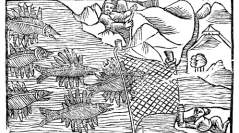

 Anthropozoologica
53 (12) - Pages 139-146
Anthropozoologica
53 (12) - Pages 139-146This article deals with the existence in medieval Irish literature, and to a lesser extent in medieval Welsh literature, of two parallel developments in the use of references to fish and aquatic or marine animals. The first is the symbolic use, often analysed as the result of the evolution of mythological accounts, such as in the legend of Taliesin. The second, lesser studied, is the descriptive use, which represents direct experience, or perhaps even to some degree social and cultural attitudes to fishing in these countries in the Middle Ages, as in the Irish poetry of the Agallamh na Senórach “Colloquy of the ancients” collection, for instance. The purpose of this article is to show that the symbolic or the mythological is but one aspect of the representation of nature in medieval Irish and Welsh literatures. It will be shown by means of a comparison between the Navigatio sancti Brendani, a Latin text of Irish origins, and the Voyage de Saint Brendan, its Anglo-Norman adaptation, that the presence of realistic elements in the representation of marine life in a text is proportional to the direct experience of the sea and of fishing on the part of the text’s audience.
Celtic Literature, salmon, medieval fishing, marine monsters, fictional representations of fish.